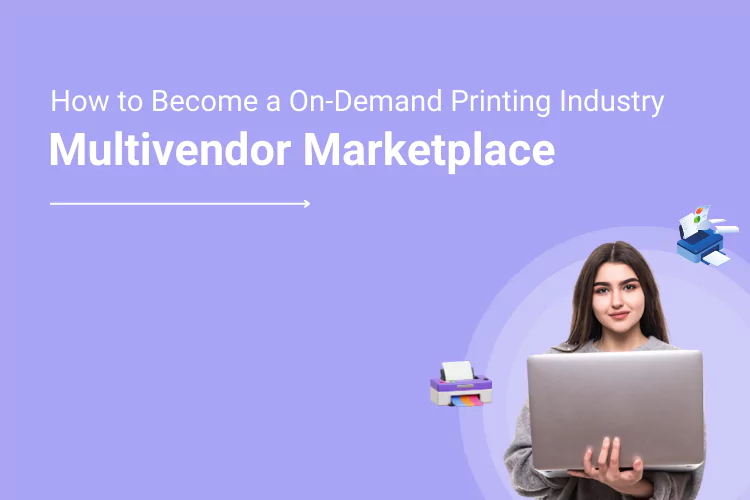E-commerce has been one of the biggest facilitators for the businesses around the world. But as change is the only constant, the platform and business models have been evolving constantly over time.
What first was just an online trade facilitator is now used by many businesses as an independent revenue generator. This means that not only can one adopt an e-commerce platform to trade their goods and services, but they can make e-commerce platforms their business offering and serve millions of customers like Amazon, e-bay and others!
Two of such biggest e-commerce business models that have been widely adopted and have become renowned for its scalability and profitability are multivendor marketplace and on-demand print shop!
The multi-vendor marketplace business model is relatively old and more adopted in comparison to the new print on-demand business model. But what makes perfect sense is the mergers of two as both these concepts are complementary to each other and are also the potential future of the e-commerce industry!
But before we look into the steps to start your multivendor marketplace of the on-demand printing industry, let’s first get a basic understanding of these two business models individually.
What is a multivendor marketplace?
The multivendor marketplace is an e-commerce solution where you invite different businesses and enterprises to sell their products and services on your platform. Each business is recognized as a vendor and they all have their personalized storefront in your marketplace.
In most of the cases, the marketplace owner manages the shipping and payments while the vendors manage product uploads, packaging and deliveries. Each vendor is an independent seller and has complete control of the pricing of their products.
What is an on-demand print shop?

On-demand print shop is an e-commerce platform where a web to print solution is integrated with the platform to empower your customers to design their own personalized and customized products. The web to print solution works as an online print design tool that can be accessed by any customer and can be used to customize different kinds of products with different customization options such as images, text, clip art and others.
Steps to create a Print on-demand marketplace?
Step 1- Identify a niche and product categories:
The first thing that you would need to do is identify the niche that you wish to target. While there are no restrictions on the categories that you could include, having a personalized platform for a specific category can also be beneficial in terms of the marketing and branding of your platform.
Make an informed decision regarding it by doing thorough market research and competitor analysis and ensure that your print on-demand marketplace has an optimum number of products included for personalization and customization as it is there the real profit lies.
Step 2- Get a personalized multi-vendor marketplace:
Based on identified industries and product categories, hire a Web to print marketplace development service provider who can help you choose an ideal marketplace platform and deliver a personalized multi-vendor marketplace. Make sure that your backend vendor portal and platform’s UI matches your stakeholders’ expectations and that it complements their digital experiences.
Also, integrate optimum personalization features in your platform to gain a competitive edge in the market. You must also have sufficient and varied payment and financing options in your platforms so that your customers can have convenience in buying. Apart from that, include all the essential automation features and functionalities to better serve your vendors as well as customers. Last but not the least, instead of searching for a marketplace development company, try to search for a web to print solution provider who can develop a marketplace too as it will ensure seamless integration and optimized development of your Multivendor marketplace for print on demand platform.
Step 3- Integrate a custom web to print software:

Once your multi-vendor marketplace is developed, the next step is to integrate a custom web to print software. Make sure that your custom web to print software can be used to customize all the products that you wish to include in your website and that it has sufficient customization options and design areas included. Also, make sure that your online print design tool is mobile responsive so that your customers can access the platform from any device.
Step 4- Collaborate with vendors and populate your platform:
Once your print on-demand marketplace is deployed and tested, invite vendors to populate your platform with their products in the respective categories. Make sure that you have a substantial range of products in all the categories before you market your platform to the customers. Also, design a few customized designs using your online print design tool to give your customers some good buying options and to test the capability of your web to print software. You can also ask vendors to create customized virtual designs of their products and put them up for sale with an on-demand print option.
Step 5- Promote your platform:

Once you have your platform up and ready, start promoting your platform to both the customers as well as the vendors. Leverage all the digital marketing platforms such as search engines, social media platforms, content marketing platforms and others for optimum reach and also plan a considerable paid as well as organic budget for your platform. Also, ask your vendors to promote their products on their respective channels so that you can gain maximum traction towards your platform. Once your customers are on your platform, give them some good promotional deals and ensure that they have a positive word of mouth as that is the ultimate marketing tool for any marketer or platform.
Wrapping up
Print on-demand marketplace is such a business model that will define the future of e-commerce. As both the concepts i.e. the multi-vendor marketplace and a print on-demand e-commerce platform are trending and are adopted widely across the globe, having a business model that merges both these platforms is no longer a question of why but when




